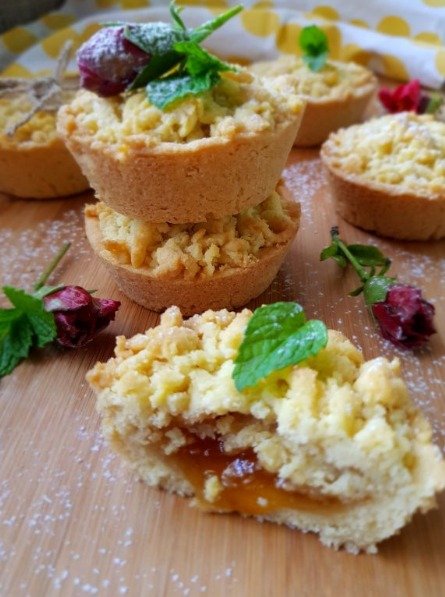The name you heard, “Krummel Tert,” is most likely a slightly misheard version of “Krémes,” which is one of Hungary’s most famous desserts. “Jam Tarts” are known as “Lekváros Bukta” or “Lekváros Táska.”
Let’s break down both of these delicious treats.
1. Krémes (The “Cream Slice”) – Possibly what you heard as “Krummel Tert”
Krémes (pronounced kray-mesh) means “creamy” and is a legendary Hungarian pastry. It’s similar to a French mille-feuille or a vanilla slice, but with its own distinct character.
Description:
-
It consists of two very large, thin, and incredibly flaky sheets of puff pastry.
-
Between them is a thick layer of a specific type of vanilla custard cream that is set firm, almost like a custard cake.
-
The top is always dusted generously with a fine layer of powdered sugar.
Key Characteristics:
-
The Cream: It’s not a light whipped cream. It’s a rich, firm, egg-yolk-based custard (vaníliakrém) that you can cut with a fork.
-
The Pastry: The puff pastry is baked to be shatteringly crisp. Eating it is a messy but delightful affair, as the powdered sugar goes everywhere with the first bite!
-
Serving: It’s always sold as a large rectangular slice from a big tray.
A Note on “Krummel”: The German/Yiddish word “Krummel” means “crumbs.” This might be a reference to the flaky, crumbly nature of the puff pastry, which could be where the mix-up came from.
2. Lekváros Bukta / Táska (Jam-Filled Pastries)
This category includes a few different shapes, all with the same delicious filling: lekvár.
What is Lekvár?
This is crucial. Lekvár is a traditional Central European fruit butter or thick jam, much denser and less sweet than typical American jams. The most common flavors are plum (szilvalekvár) and apricot (baracklekvár).
Here are the main types of jam tarts:
a) Lekváros Bukta (Bukta)
-
Description: This is a baked or steamed bun made from a soft, yeasted dough. The dough is rolled out, cut into squares, a dollop of lekvár is placed in the center, and the dough is pinched together to form a pouch or pillow.
-
Characteristics: They are often baked close together in a pan so they touch, creating soft sides. After baking, they are brushed with melted butter and dusted with powdered sugar. The texture is soft and pillowy.
b) Lekváros Táska (“Jam Purse” or Turnover)
-
Description: This is the most direct equivalent of a “jam tart.” It’s made from either a shortcrust pastry (rétes-tészta) or a flaky pastry.
-
Characteristics: The pastry is rolled out, cut into circles or squares, filled with lekvár, folded over into a half-moon or triangle shape, and the edges are crimped with a fork. It’s then baked until golden brown. It’s essentially a hand-sized jam turnover.
c) Lekváros Kifli (“Jam Crescent”)
-
Description: Similar to the táska, but the dough is shaped into a crescent (kifli). This can be made with a flaky pastry or a more cookie-like dough.
Recipe Idea: Simple Lekváros Táska (Jam Turnovers)
If you’d like to try making the jam tarts at home, here’s a simplified recipe.
Ingredients:
-
2 cups all-purpose flour
-
1/2 teaspoon salt
-
1 cup (2 sticks) cold unsalted butter, cubed
-
1/2 cup sour cream or plain yogurt (this makes the pastry tender)
-
1 jar of plum or apricot lekvar (or use a thick, high-quality jam)
-
1 egg, beaten (for egg wash)
-
Powdered sugar for dusting
Instructions:
-
Make the Dough: In a food processor or bowl, combine the flour and salt. Add the cold, cubed butter and pulse (or use a pastry cutter) until the mixture resembles coarse crumbs. Add the sour cream and mix until the dough just comes together. Do not overwork.
-
Chill: Shape the dough into a disk, wrap in plastic, and refrigerate for at least 1 hour.
-
Preheat Oven: Preheat your oven to 375°F (190°C). Line a baking sheet with parchment paper.
-
Shape the Tarts: On a floured surface, roll the dough out to about 1/8-inch thickness. Use a round cookie cutter or a glass to cut out circles (about 4-5 inches in diameter).
-
Fill: Place a heaping teaspoon of lekvár in the center of each circle. Brush the edges of the circle with a little water. Fold the dough over the filling to create a half-moon shape. Press the edges firmly with your fingers, then crimp them with a fork to seal.
-
Bake: Place the turnovers on the prepared baking sheet. Brush the tops with the beaten egg. Bake for 20-25 minutes, or until puffed and golden brown.
-
Serve: Let them cool slightly on a wire rack. Dust generously with powdered sugar before serving. They are best warm!
Enjoy your journey into Hungarian baking! These pastries are perfect with a cup of coffee or tea.
